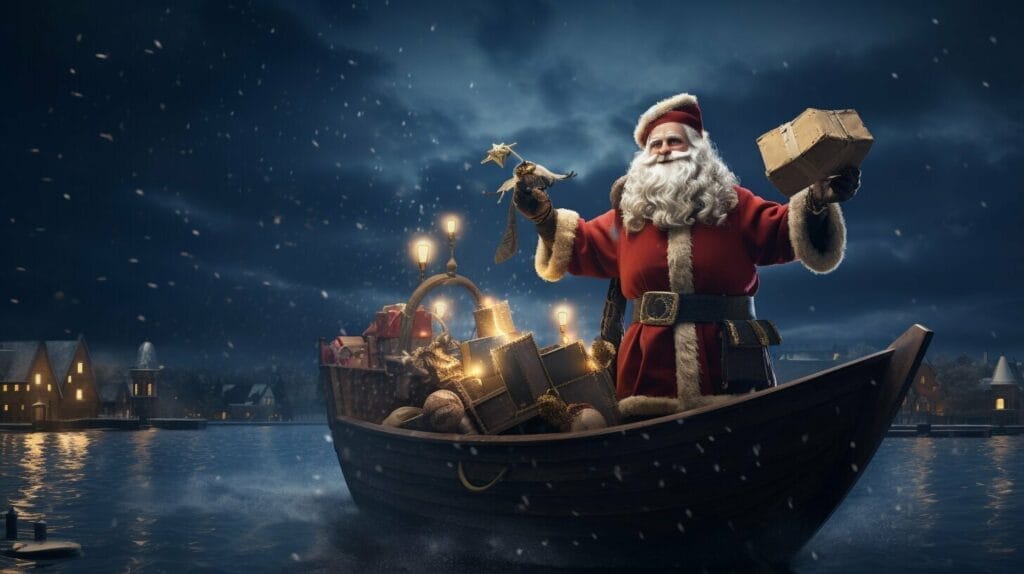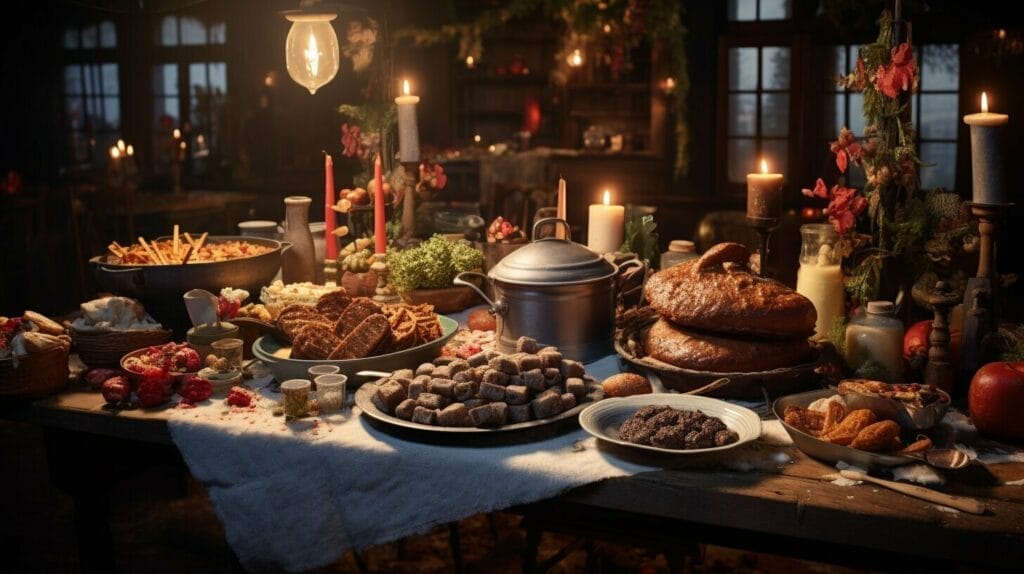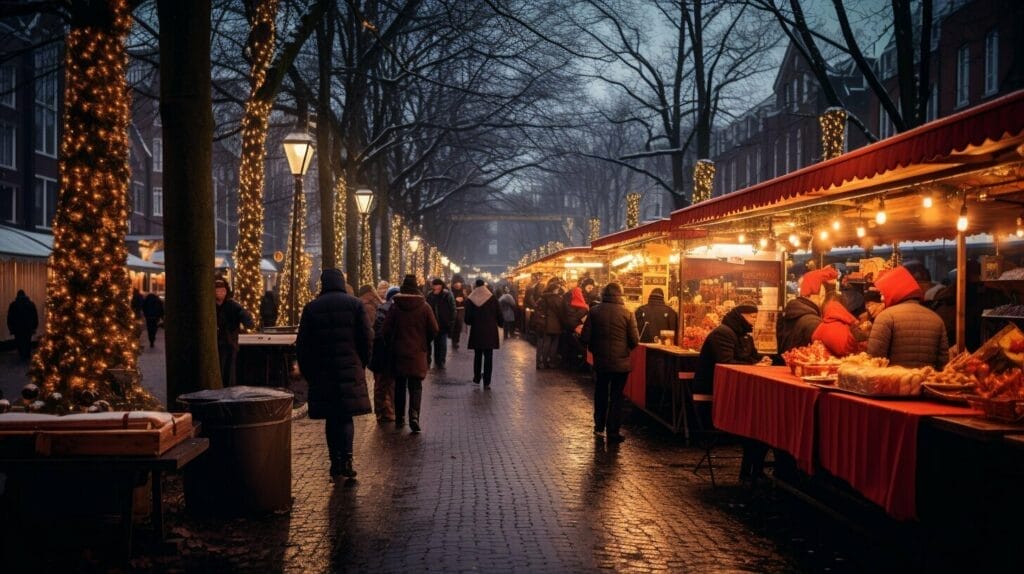Dutch Christmas Traditions
Are you ready to discover the enchanting world of Dutch Christmas traditions? The Netherlands celebrates the season like no other, with beloved figures like Sinterklaas and Zwarte Piet, festive foods, songs, and holiday customs that have been passed down for generations.
Join us on a journey through the wonder and magic of Dutch Christmas traditions, and learn why this time of year in Europe is so special in the Netherlands.

Key Takeaways:
- Discover the enchanting world of Dutch Christmas traditions.
- Learn about beloved figures like Sinterklaas and Zwarte Piet.
- Explore mouthwatering festive foods and holiday customs.
- Immerse yourself in the joyous atmosphere of Dutch December celebrations.
- Experience the beauty of Dutch Christmas decorations and trees.
Sinterklaas and Zwarte Piet
As you explore Dutch Christmas traditions, you cannot help but come across the beloved figure of Sinterklaas, the Dutch version of St. Nicholas. Celebrated on December 5th, St. Nicholas Day (known as Sinterklaasavond) is a major event in the Dutch holiday calendar. Accompanying Sinterklaas on his journey through the country is his trusty sidekick, Zwarte Piet.
Zwarte Piet, or Black Pete, has a tumultuous history, with debates and discussions surrounding the character’s depiction and origins. Despite controversy, he is a beloved figure among Dutch children, known for his playful antics and mischievous nature. The story goes that Sinterklaas and Zwarte Piet travel from Spain to the Netherlands each year, bringing gifts and treats for well-behaved children and lumps of coal for naughty ones.
The traditions surrounding Sinterklaas and Zwarte Piet are numerous and enchanting. From the arrival of Sinterklaas by steamboat to the festive parades and gift-giving, there’s something magical about the celebration. Whether you’re a local or a visitor, it’s worth experiencing the joy and wonder of St. Nicholas Day in the Netherlands.

On St. Nicholas Day, children leave out their shoes in the hopes that Sinterklaas will fill them with small gifts and sweets. The Dutch also have a tradition of writing humorous poems about family and friends, which they recite while exchanging presents. And, of course, no celebration of Sinterklaas would be complete without the traditional treat of pepernoten and speculaas.
Despite the ongoing discussions about the character of Zwarte Piet, he remains a fixture in the Dutch holiday season. From chocolate replicas to parade costumes, you’ll see the character’s likeness everywhere you turn, particularly in the weeks leading up to St. Nicholas Day.
Overall, the traditions surrounding Sinterklaas and Zwarte Piet are a magical and integral part of Dutch Christmas celebrations. Whether you’re a child eagerly waiting for gifts or an adult soaking in the festive atmosphere, the joy and wonder of this beloved holiday figure is sure to captivate you.
Dutch Festive Foods
Get ready to indulge in the mouthwatering flavors of Dutch holiday cuisine, where traditional treats like kerstkransjes, oliebollen, and speculaas abound. Kerstkransjes, or Christmas wreath cookies, are a buttery shortbread-like cookie, shaped into a wreath and topped with sugar crystals for a festive touch. Oliebollen, or “oil balls,” are a type of Dutch doughnut, deep-fried and dusted with powdered sugar. They are a staple at New Year’s Eve parties, but also enjoyed throughout the holiday season.
Gourmetten, a traditional Dutch Christmas feast, involves cooking meats and vegetables on a small tabletop grill with family and friends. Kerststol is a Dutch sweet bread loaf studded with raisins and almonds, and is often served on Christmas morning. Nieuwjaarsrolletjes, or “New Year’s rolls,” are a crispy wafer cookie filled with sweet almond paste, traditionally eaten on New Year’s Day.
No Dutch holiday spread is complete without the beloved pepernoten, small spiced cookies often enjoyed during the Sinterklaas festivities. Speculaas, a spiced cookie often baked in the shape of windmills or other Dutch figures, is another holiday favorite. And of course, Dutch holiday desserts such as banketstaaf, a flaky pastry filled with almond paste, and gevulde speculaas, a spiced cookie filled with almond paste and sometimes fruit, are sweet endings to any holiday meal.

As you can see, the Dutch take their holiday cuisine seriously, with a variety of delicious treats to enjoy throughout the season. Whether you’re indulging in oliebollen at a New Year’s Eve party or savoring kerststol on Christmas morning, the flavors of Dutch Christmas will surely delight.
Dutch December Celebrations
Get ready to experience the festive atmosphere of Dutch December celebrations! The Netherlands has a plethora of traditions and customs during this time of year, making it a magical time to visit. From Christmas markets to midwinter hornblowing, there’s something for everyone.
Dutch Christmas Markets
One of the highlights of Dutch December celebrations is the abundance of Christmas markets. The markets are filled with stalls selling everything from festive treats to handmade crafts. The most well-known market is the Amsterdam Christmas market, which is located in the center of the city. Here you can find traditional Dutch treats like poffertjes, delicious mini pancakes, and erwtensoep, a hearty pea soup.

If you’re in the eastern part of the Netherlands during December, you might hear the enchanting sound of midwinter hornblowing. This tradition dates back to pagan times, and it involves blowing a long wooden horn to scare away evil spirits. Today, it’s mainly used as a festive tradition and an opportunity for communities to come together.
Dutch Advent Traditions
The Dutch celebrate Advent in a unique way. Children put their shoes out by the fireplace, and Sinterklaas and Zwarte Piet fill them with traditional sweets like pepernoten and speculaas. On December 5th, the Dutch celebrate the St. Nicholas Feast, a day filled with gift-giving and festive treats.
Dutch Yule Log
Another Dutch December tradition is the Yule log, known as Kerstblok in Dutch. The log is made from a tree branch and decorated with candles and festive decorations. On Christmas Eve, the Yule log is lit, and families gather around to sing carols and enjoy each other’s company.
Overall, Dutch December celebrations are a must-see for anyone interested in experiencing the magic of the holiday season. From Christmas markets to midwinter hornblowing, there’s something for everyone. Don’t miss out on this enchanting time of year!
Dutch Christmas Eve and Beyond
As Dutch Christmas draws to a close, the festivities continue with Dutch Christmas Eve, or Kerstavond. This is a time for families to gather together and enjoy a meal, exchange gifts, and attend church services. Many people also take the opportunity to view the beautiful Dutch Christmas decorations that adorn homes and public spaces.
The following day, December 25th, is known as Kerstmis, or Christmas Day. This is a time for reflection, family, and relaxation. The Dutch celebrate Christmas for twelve days, leading up to Epiphany on January 6th, which is also a public holiday.
During this extended holiday period, the Netherlands is filled with winter festivals, markets, and other celebrations. Many businesses give their employees kerstpakket, or Christmas hampers, filled with delicious treats and gifts.
One beloved tradition during this time is the Dutch Christmas tree, adorned with lights and decorations, which brings warmth and joy to homes and public spaces alike.
Epiphany in the Netherlands, also known as Driekoningen, is celebrated on January 6th. This day commemorates the visit of the three wise men to the baby Jesus and is marked by special church services and parades. The festivities of the Dutch Christmas season come to a close with Epiphany, but the memories and traditions live on until the next year.
Experience the wonder and joy of Dutch Christmas Eve and beyond, as you immerse yourself in the enchanting celebrations, delicious foods, and customs that make the holiday season in the Netherlands so special.
FAQ
Q: What are some Dutch Christmas traditions?
A: Dutch Christmas traditions include celebrating Sinterklaas and his sidekick Zwarte Piet, enjoying festive foods like kerstkransjes and oliebollen, and participating in December celebrations like the midwinter hornblowing ritual and Christmas markets.
Q: Who is Sinterklaas and Zwarte Piet?
A: Sinterklaas is the Dutch version of St. Nicholas, known for his red robe and white beard. Zwarte Piet is Sinterklaas’ mischievous companion, often portrayed in blackface. They are central figures in Dutch Christmas celebrations.
Q: What are some traditional Dutch festive foods?
A: Traditional Dutch festive foods include kerstkransjes (Christmas wreath cookies), oliebollen (deep-fried doughnuts), gourmetten (a tabletop grilling tradition), kerststol (Christmas fruit bread), and pepernoten (spiced cookies).
Q: What are some Dutch December celebrations?
A: Dutch December celebrations include visiting Christmas markets, witnessing the midwinter hornblowing ritual, and participating in Advent traditions. The Dutch St. Nicholas Feast and the tradition of the Dutch Yule log are also significant during this time.
Q: What is the significance of Epiphany and Dutch Christmas Eve?
A: Epiphany in the Netherlands marks the end of the Christmas season, while Dutch Christmas Eve is a time of family gatherings and celebrations. The twelve days of Christmas are also observed, and Dutch winter festivals take place. The tradition of kerstpakket (Christmas hamper) and decorating Dutch Christmas trees are also important.




